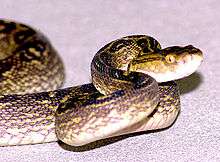Triflin
Triflin is a cysteine-rich secretory protein (CRISP), which is excreted by the venom gland of the Habu snake (Trimeresurus flavoviridis).[1] Triflin reduces high potassium-induced smooth muscle contraction, suggesting a blocking effect on L-type calcium channels.[2]
Sources

Triflin is a toxin derived from snake venom. The toxin is produced in the gland of the Habu snake, Trimeresurus flavoviridis.[1]
Chemistry
Triflin is a cysteine-rich secretory protein, which means it belongs to the CRISP family. This is a group of single chain polypeptides found in various organisms. Triflin weighs 25 kDa and consists of 221 amino-acid residues. The first 163 residues of the N-terminal domain forms an α-β-α sandwich core. This domain is comparable with group 1 plant pathogenesis-related protein (PR-1). The C-terminal domain, has five disulfide bridges. This domain is responsible for the selectivity of the protein and consists of two subdomains: N-terminal subdomain (Cys 167 to Cys 179) and C-terminal subdomain (42 amino-acids residues). The N-terminal subdomain is connected with N-terminal domain through two main-chain hydrogen bonds between β11 and β2 and is thereby part of the PR-1 domain. The C-terminal subdomain is stabilized by three disulfide bridges and it is remarkable that this domain does not interact with either the PR-1 domain or the N-terminal sub-domain. The C-terminal subdomain consists of particles, including some hydrophobic residues that are exposed to the solvent. These hydrophobic residues might mediate the interaction with the target proteins and therefore receptor recognition.[1]
There are some homologous toxins to Triflin with different percentages of amino-acid sequence similarity, such as Ablomin, Latisemin, Stecrip (88%), Helothermine (49%),[2] Pseudechetoxin (62%), Pseudesin (61%).[3] The snake venoms which belong to CRISP family seem to be homologous to each other, however there are differences in their protein targets.[1]
Target
Triflin reduces high potassium induced smooth muscle contraction, suggesting a blocking effect on L-type calcium channels.[2]
Treatment
One of the small serum proteins (SSP-2), a substance produced by Trimeresurus flavoviridis itself, has high affinity for Triflin, and may thus work as a defensive mechanism against accidental self-poisoning, suggesting a possible role for SSP-2 as an antidote to triflin.[4]
See also
- Other snake venom proteins in the CRISP family:
- Piscivorin from the Eastern Cottonmouth
- Latisemin from the Erabu snake
- Ablomin from the Mamushi snake
- Ophanin from the King Cobra
References
- Y, Shikamoto; Suto, K; Yamazaki, Y; Morita, T; Mizuno, H (2005). "Crystal structure of a CRISP family calcium-channel blocker derived from snake venom". Journal of Molecular Biology. 350 (4): 735–743. doi:10.1016/j.jmb.2005.05.020. PMID 15953617.
- Y. Yamasaki; Koike, H; Sugiyama, Y; Motoyoshi, K; Wada, T; Hishinuma, S; Mita, M; Morita, T (2002). "Cloning and characterization of novel snake venom proteins that block smooth muscle contraction". Eur. J. Biochem. 269 (11): 2708–2715. doi:10.1046/j.1432-1033.2002.02940.x. PMID 12047379.
- N, Suzuki; Yamazaki, Y; Fujimoto, Z; Morita, T; Mizuno, H (2005). "Crystallization and preliminary X-ray diffraction analyses of pseudechetoxin and pseudecin, two snake-venom cysteine-rich secretory proteins that target cyclic nucleotide-gated ion channels". Acta Crystallogr F. 61 (Pt 8): 750–752. doi:10.1107/S1744309105020439. PMC 1952345. PMID 16511147.
- Aoki, N; Sakiyama, A; Deshimaru, M; Terada, S (2007). "Identification of novel serum proteins in a Japanese viper: homologs of mammalian PSP94". Biochemical and Biophysical Research Communications. 359 (2): 330–4. doi:10.1016/j.bbrc.2007.05.091. PMID 17543280.